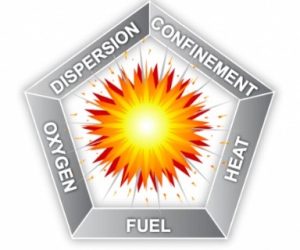Combustible Dust: A Hidden Hazard
Posted: October 2nd, 2023
Authors: Daniel H.
In many industries, safety concerns revolve around visible hazards such as machinery, chemicals, and fire. However, there’s a lesser-known danger that can lead to catastrophic incidents: combustible dust. This seemingly innocuous substance, often formed during various processes, has the potential to turn into a deadly explosion under the right conditions. In this blog, we’ll delve into what combustible dust is, its sources, risks, preventive measures, and the importance of proper management.
What is combustible dust?
Combustible dust refers to fine particles that are generated during various industrial processes such as grinding, cutting, drilling, and handling of materials like wood, metal, chemicals, or food products. These particles, typically smaller than 420 micrometers (µm) in diameter, can become suspended in the air, forming a dangerous mixture. If ignited, this mixture can cause a rapid combustion known as a dust explosion.
 The conditions necessary for a combustible dust explosion to occur are often referred to as the “Dust Explosion Pentagon,” which includes the following elements:
The conditions necessary for a combustible dust explosion to occur are often referred to as the “Dust Explosion Pentagon,” which includes the following elements:
- Combustible Dust: The presence of finely divided, combustible particles. This is considered the fuel in the pentagon.
- Oxygen: The availability of oxygen in the air.
- Ignition Source: A spark, flow, hot surface, or other heat source that can ignite the combustible dust-air mixture.
- Dispersion: The dust particles must be suspended in the air in a cloud-like concentration.
- Confinement: The dust mixture must be confined within a limited space, such as a room or piece of equipment.
What is a Dust Hazard Analysis?
As per the National Fire Protection Agency (NFPA)’s Code 652, Standard on the Fundamentals of Combustible Dust, a dust hazard analysis (DHA) is a systematic methodology for evaluating the potential fire, deflagration and explosion hazards associated with combustible dust in a facility or process. When properly conducted, a DHA will allow an individual to assess and identify the risks posed by dust accumulation and the presence of ignition sources to develop appropriate safety measures for a facility. A properly conducted DHA will follow these procedures:
- Dust Inventory: Identify and document all sources and types of combustible dust present within the facility, such as the characteristics, quantities, and location within the facility.
- Hazard Assessment: Evaluate the characteristics identified (i.e., particle size and concentration) and identify any nearby sources of ignition (i.e., electrical equipment, hot surfaces and open flames).
- Risk Evaluation: Determine the consequences of a deflagration incident. This can be done by assessing the risk level associated with each dust and ignition source combination. Quantitative methods of prioritizing hazards, such as a risk matrix, can help to evaluate risk.
- Mitigation Measures: Develop operating procedures that minimize the risk associated with the identified sources of combustible dust and ignition, such as venting or inerting practices.
- Documentation: Record and document the analysis, findings, and action(s) taken for all dust hazard analysis and mitigation practices.
NFPA 652 mandates the completion of a DHA for new and existing processes and facility compartments in industries where combustible dust may be present. The standard also requires the DHA to be reviewed and updated every five years. Changes in processes, new processes after an initial DHA require another or updated DHA as well.
Additional control and safety Provisions
The NFPA has also outlined additional control and safety provisions to be incorporated at a facility in order to mitigate the risk of an accidental fire or deflagration event. For example, NFPA 654, Standard for the Prevention of Fire and Dust Explosions from the Manufacturing, Processing, and Handling of Combustible Particulate Solids, contains comprehensive guidance on the control of dusts, ignition sources, and facility-wide risk management practices that contribute to minimizing the danger and damage sustained from any accident, along with additional resources for guidance, as outlined below in Table 1.
Table 1
NFPA 654: Additional Control Measures
| Control Factor | Recommendations | Further Resources |
| Dusts |
|
29 CFR 1910.94 |
| Ignition Sources |
|
29 CFR 1910.307 |
| Housekeeping Practices |
|
NFPA 69 |
Proposed Regulation
The NFPA is currently in the process of clarifying and consolidating all combustible dust standards into one single standard, designated as NFPA 660: Standard for Combustible Dusts. At the moment, NFPA 660 is in the Fall 2024 revision cycle, with a first edition likely to be released in early 2025. The first window for public input on NFPA 660 ended in early January 2023, and the standard is being reviewed by committee members. The standard will again be open for public input and subsequent review by the committee before eventual adoption and release. Risk management and loss control organizations will likely be emphasizing combustible dust standards during this development period as well.
What does this mean for my facility?
Since the Occupational Health and Safety Administration (OSHA) created the Combustible Dust National Emphasis Program (NEP), OSHA inspectors have cited employers for numerous combustible-dust hazards under the General Duty Clause (GDC). OSHA has not adopted specific standards for combustible dust, therefore, the GDC remains OSHA’s primary regulatory enforcement tool. For OSHA to successfully cite a facility for violating the GDC, present and relevant hazards must be1:
- Exposed to employees of the facility.
- Recognized by the industry or employer.
- Likely to cause / have already caused death or serious physical harm.
- Feasibly correctable with available means.
OSHA has cited the NFPA combustible dust standards as evidence of all three of the GDC requirements. Many of OSHA’s combustible dust citations can also be issued under current standards such as poor hazard communication, substandard housekeeping, under-maintained electrical components, a lack of appropriate personal protective equipment, or a lack of fire extinguishers.
Furthermore, the National Electric Code (NEC), drafted in NFPA 70, defines hazardous locations as those areas “where fire or explosion hazards may exist due to flammable gases or vapors, flammable liquids, combustible dust, or ignitable fibers.” Under the NEC, facilities where the presence of combustible dust in the air is in sufficient quantities to be explosive or ignitable are designated as class II hazardous locations. As a result, these hazardous locations are subject to specific safety provisions as determined by state or local law to prevent accidental fires or deflagration incidents.
Although NFPA 660 is still far from implementation, it is not too early for facility owners and operators to gain a greater understanding of what the new standard is intended to provide and accomplish. To prepare for the eventual implementation of NFPA 660 into regulation, facilities can familiarize themselves with the standards that will be put into place and with the essential housekeeping practices needed to keep their site free of hazards relating to combustible dust. All4 will continue to follow the progression of NFPA 660 as it undergoes further development through public input and committee review. Upon being finalized, All4 will publish another article further examining the standards implemented within NFPA 660, along with information relating to any regulatory implementation that applies at that time.
ALL4 has many experts in the organization that can assist with conducting a proper dust hazard analysis and implementing proper safety provisions at your facility. If you have questions or concerns about the standards and practices surrounding combustible dust and you’d like to discuss them, contact Daniel Hickey at Dhickey@all4inc.com.

